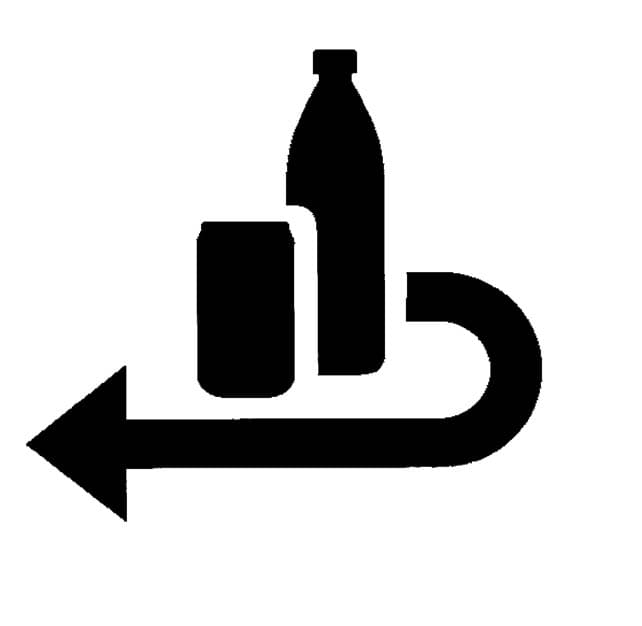
Keine benutzung
der Marke für
Einwegpfand.
Keine benutzung
der Marke für
Einwegpfand.
von
In Deutschland prangt die Marke für Einwegpfand auf allen Einwegflaschen und Getränkedosen. Warum diese Marke trotzdem nicht rechtserhaltend benutzt wird und wie man es hätte besser machen können, klärt das Europäische Gericht erster Instanz.
Einwegpfandsymbol
Die Deutsche Pfandgesellschaft ist Inhaberin einer EU Bildmarke. Die Marke ist seit Juni 2007 als Individualmarke unter anderem für diverse Dienstleistungen eingetragen, darunter
- Abfallwirtschaftliche Verwaltungstätigkeit
- technische Abfallberatung und Öffentlichkeitsarbeit
- Abtransport und Lagern von Abfall- und Recyclingstoffen
- Rücknahme von leeren Einwegverpackungen und Einwegverpackungsbehältern
- Sammeln, Erfassen, Transportieren und Zwischenlagern von Getränkebehältern
- Betrieb eines Pfandsystems (Markierung, Sammeln, Erfassen, Transportieren und Zwischenlagern von Getränkbehältern)
- Müll- und Abfallrecycling; Sortieren von Getränkbehältern
- Entwicklung und Umsetzung in technischer Hinsicht von Rücknahmesystemen für Verpackungen der unterschiedlichsten Stoffgruppen, der unterschiedlichsten Größe und Herkunft sowie der unterschiedlichsten Verwertungsmöglichkeiten und ab den verschiedensten Anfallstellen

Auf Basis dieser Marke legte die DPG Deutsche Pfandsystem GmbH Widerspruch gegen eine recht ähnliche Marke ein.
EUIPO verneint Benutzung der Marke für Einwegpfand
Im Rahmen des Widerspruchsverfahrens erhob der Anmelder des jüngeren Zeichens die Einrede der Nichtbenutzung, da die Marke der DPG älter als 5 Jahre ist. Die DPG legte daraufhin Fotos einer Getränkedose, einer Kunststoffflasche, eines Etiketts, das auf automatischen Verwertungs- und Sortieranlagen für Verpackungen verwendet wird, Auszüge aus ihrer Website ” und ein Dokument mit den Bedingungen für die Teilnahme am DPG-System vor.
Dies reichte der Widerspruchsabteilung des EUIPO jedoch nicht als Nachweis für die ernsthafte Benutzung und wies den Widerspruch deshalb in vollem Umfang zurück. Die Beschwerdekammer des EUIPO schloss sich dieser Auffassung in der Folge an und stellte fest, dass die Einwegpfand Marke der DPG von den maßgeblichen Verkehrskreisen nicht als Hinweis darauf wahrgenommen werde, dass die betreffenden Waren oder Dienstleistungen von einem bestimmten Unternehmen stammten, unter dessen Kontrolle sie hergestellt oder erbracht würden. Das Zeichen werde vielmehr als beschreibende Angabe wahrgenommen, die darüber informiere, dass die Waren zu einer bestimmten Warengruppe gehörten, nämlich zu den Waren mit Einwegverpackungen, die der Pfandpflicht unterlägen. Außerdem werde das Zeichen von den gewerblichen Verbrauchern, die an diesem System teilnähmen und sich mit den Verwaltungs- und Rechtsdokumenten der Klägerin vertraut machten, als offizielle Kennzeichnung und nicht als Marke verwendet, die auf die betriebliche Herkunft der von diesem Zeichen erfassten Dienstleistungen hinweise. Schließlich würde die DPG und ihre Dienstleistungen in den Dokumenten und auf ihrer Website durch ihren Namen identifiziert, während die Verwendung der Marke nur dekorativen Zwecken diene.
EuG: Keine Benutzung als Individualmarke
Das EuG (Urteil vom 06.09.2023 – Az. T-774/21) stimmt der Auffassung des EUIPO zu und verneint eine rechtserhaltende Benutzung. Die ernsthafte Benutzung sei entsprechend ihrer Hauptfunktion zu beurteilen und dies sei bei einer Individualmarke die Herkunftsfunktion.
Wenn eine Individualmarke als ein Zeichen wahrgenommen wird, das zwar die Zusammensetzung oder die Qualität der Waren oder Dienstleistungen bescheinigen soll, aber nicht garantiert, dass die damit gekennzeichneten Waren oder Dienstleistungen von einem einzigen Unternehmen stammen, unter dessen Kontrolle sie hergestellt oder erbracht werden und das folglich für die Qualität dieser Waren oder Dienstleistungen verantwortlich ist, liege keine Benutzung dieses Zeichens als Hinweis auf die betriebliche Herkunft vor. So verhält es sich laut EuG auch im vorliegenden Fall.
Das EuG weist in diesem Zusammenhang darauf hin, dass es sich gerade nicht um eine Gewährleistungsmarke handelt. Damit deutet das EuG an, dass die Nachweise für die Benutzung einer Gewährleistungsmarke wohl ausgereicht hätten.
Fazit
Die Entscheidung macht deutlich, dass auch eine so vielfach benutzte Marke wie das Zeichen des Einwegpfand nicht unbedingt im Rechtssinne benutzt wird, wenn man die falsche Markenkategorie gewählt hat.
Zwar gab es die Gewährleistungsmarke zum Zeitpunkt der Anmeldung der Marke der DPG noch nicht (diese wurde auf EU-Ebene erst 2017 eingeführt), aber die DPG wäre gut beraten gewesen, diese mit deren Einführung anzumelden. Nun ist die Marke nach der Entscheidung des EuG wohl löschungsreif.
Es gibt nach wie vor viele Markeninhaber die ihre Marken eigentlich als Gewährleistungsmarken nutzen, aber nur Inhaber von Individualmarken sind. Diese riskieren ohne durchsetzbare Rechte dazustehen.
Eine ausführliche Besprechung der Entscheidung von mir zusammen mit Robert Taeger ist in der GRUR-Prax 2003, 593 veröffentlicht.
Wir beraten
Sie gerne zum
Markenrecht!






